Exceptionally High 2018 Equilibrium Line Altitude on Taku Glacier, Alaska
Abstract
1. Introduction
2. Materials and Methods
3. Results
4. Discussion
5. Conclusions
Funding
Acknowledgments
Conflicts of Interest
References
- Østrem, G. The transient snowline and glacier mass balance in southern British Columbia and Alberta, Canada. Geogr. Ann. A 1973, 55, 93–106. [Google Scholar] [CrossRef]
- Hall, D.K.; Chang, A.; Foster, J.; Benson, C.; Kovalick, W. Comparison of in situ and Landsat derived reflectance of Alaskan glaciers. Remote Sens. Environ. 1989, 28, 23–31. [Google Scholar] [CrossRef]
- Pelto, M.S. Utility of late summer transient snowline migration rate on Taku Glacier, Alaska. Cryosphere 2011, 5, 1127–1133. [Google Scholar] [CrossRef]
- Mernild, S.; Pelto, M.; Malmros, J.; Yde, J.; Knudsen, N.; Hanna, E. Identification of snow ablation rate, ELA, AAR and net mass balance using transient snowline variations on two Arctic glaciers. J. Glaciol. 2013, 59, 649–659. [Google Scholar] [CrossRef]
- Hock, R.; Koostra, D.; Reijmeer, C. Deriving glacier mass balance from accumulation area ratio on Storglaciären, Sweden. In, Glacier Mass Balance Changes and Meltwater Discharge. Int. Assoc. Hydrol. Sci. 2007, 318, 163–170. [Google Scholar]
- Barandun, M.; Huss, M.; Usubaliev, R.; Azisov, E.; Berthier, E.; Kääb, A.; Bolch, T.; Hoelzle, M. Multi-decadal mass balance series of three Kyrgyz glaciers inferred from modelling constrained with repeated snow line observations. Cryosphere 2018, 12, 1899–1919. [Google Scholar] [CrossRef]
- Cogley, J.G.; Hock, R.; Rasmussen, L.A.; Arendt, A.A.; Bauder, A.; Braithwaite, R.J.; Jansson, P.; Kaser, G.; Möller, M.; Nicholson, L.; et al. Glossary of Glacier Mass Balance and Related Terms, Technical Documents in Hydrology No. 86; UNESCO-IHP: Paris, France, 2011. [Google Scholar]
- Hulth, J.; Rolstad, J.; Denby, C.; Hock, R. Estimating glacier snow accumulation from backward calculation of melt and snowline tracking. Ann. Glaciol. 2013, 54. [Google Scholar] [CrossRef]
- Tawde, S.; Kulkarni, A.; Bala, G. Estimation of glacier mass balance on a basin scale: An approach based on satellite-derived snowlines and a temperature index model. Curr. Sci. 2016, 111, 1977–1989. [Google Scholar] [CrossRef]
- Pelto, M.; Miller, M. Mass Balance of the Taku Glacier, Alaska from 1946 to 1986. Northwest Sci. 1990, 64, 121–130. [Google Scholar]
- Pelto, M.; Kavanaugh, J.; McNeil, C. Juneau Icefield Mass Balance Program 1946–2011. Earth Syst. Sci. Data 2013, 5, 319–330. [Google Scholar] [CrossRef]
- WGMS. Global Glacier Change Bulletin No. 1 (2012–2013); ICSU(WDS)/IUGG(IACS)/UNEP/UNESCO/WMO, Zemp, M., Gärtner-Roer, I., Nussbaumer, S.U., Hüsler, F., Machguth, H., Mölg, N., Paul, F., Hoelzle, M., Eds.; World Glacier Monitoring Service: Zurich, Switzerland, 2015; p. 230. [Google Scholar]
- LaChapelle, E. Snow Studies on the Juneau Icefield; American Geographical Society: Boston, MA, USA, 1954. [Google Scholar]
- Landsat 8 OLI/TIRS Digital Object Identifier. 2019. Available online: https://www.usgs.gov/centers/eros/science/usgs-eros-archive-landsat-archives-landsat-8-oli-operational-land-imager-and?qt-science_center_objects=0#qt-science_center_objects (accessed on 18 July 2018).
- U.S. Geological Survey. The National Map—New Data Delivery Homepage, Advanced Viewer, Lidar Visualization; US. Geological Survey Fact. Sheet 2019–3032: Reston, VA, USA, 2019.
- National Weather Service. Juneau and Area Climate Information. Available online: www.weather.gov/ajk/localclimate/ (accessed on 10 July 2019).
- Abatzoglou, J. Influence of the PNA on Declining Mountain Snowpack in the Western United States. Int. J. Climatol. 2011, 31, 1135–1142. [Google Scholar] [CrossRef]
- Patel, K. Snow Swamp on Lowell Glacier; NASA Earth Observatory: Greenbelt, MD, USA, 2018. Available online: https://earthobservatory.nasa.gov/images/92699/snow-swamp-on-lowell-glacier (accessed on 8 September 2018).
- Criscitiello, A.; Kelly, M.; Tremblay, B. The Response of Taku and Lemon Creek Glaciers to Climate. Arct. Antarct. Alp. Res. 2010, 42, 34–44. [Google Scholar] [CrossRef]
- Melkonian, A.; Willis, M.; Pritchard, M. Satellite-derived volume loss rates and glacier speeds for the Juneau Icefield, Alaska. J. Glaciol. 2014, 60, 743–760. [Google Scholar] [CrossRef]
- Zemp, M.; Frey, H.; Gärtner-Roer, I.; Nussbaumer, S.U.; Hoelzle, M.; Paul, F.; Haeberli, W.; Denzinger, F.; Ahlstrøm, A.P.; Anderson, B.; et al. Historically unprecedented global glacier decline in the early 21st century. J. Glaciol. 2015, 61, 745–762. [Google Scholar] [CrossRef]
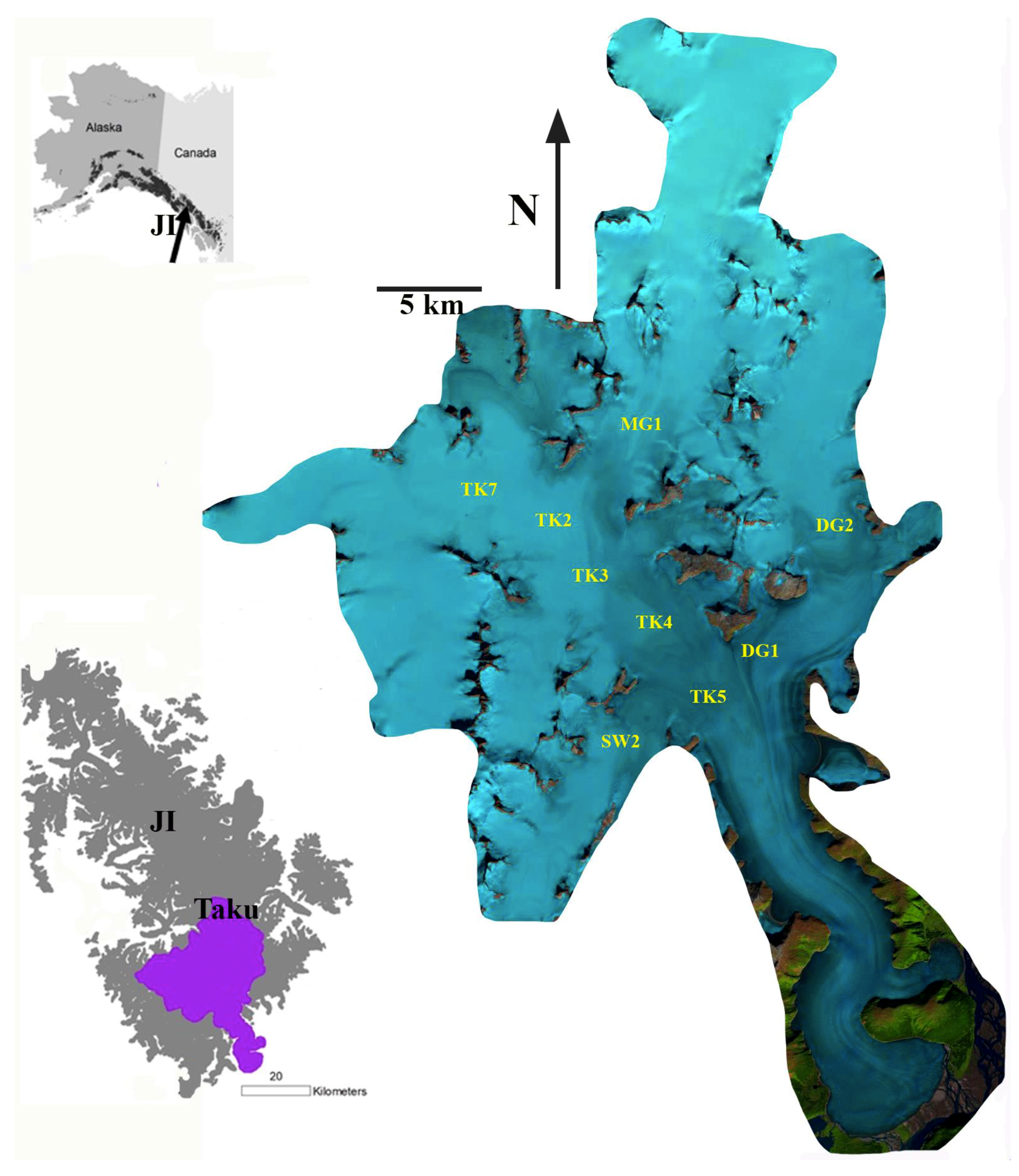
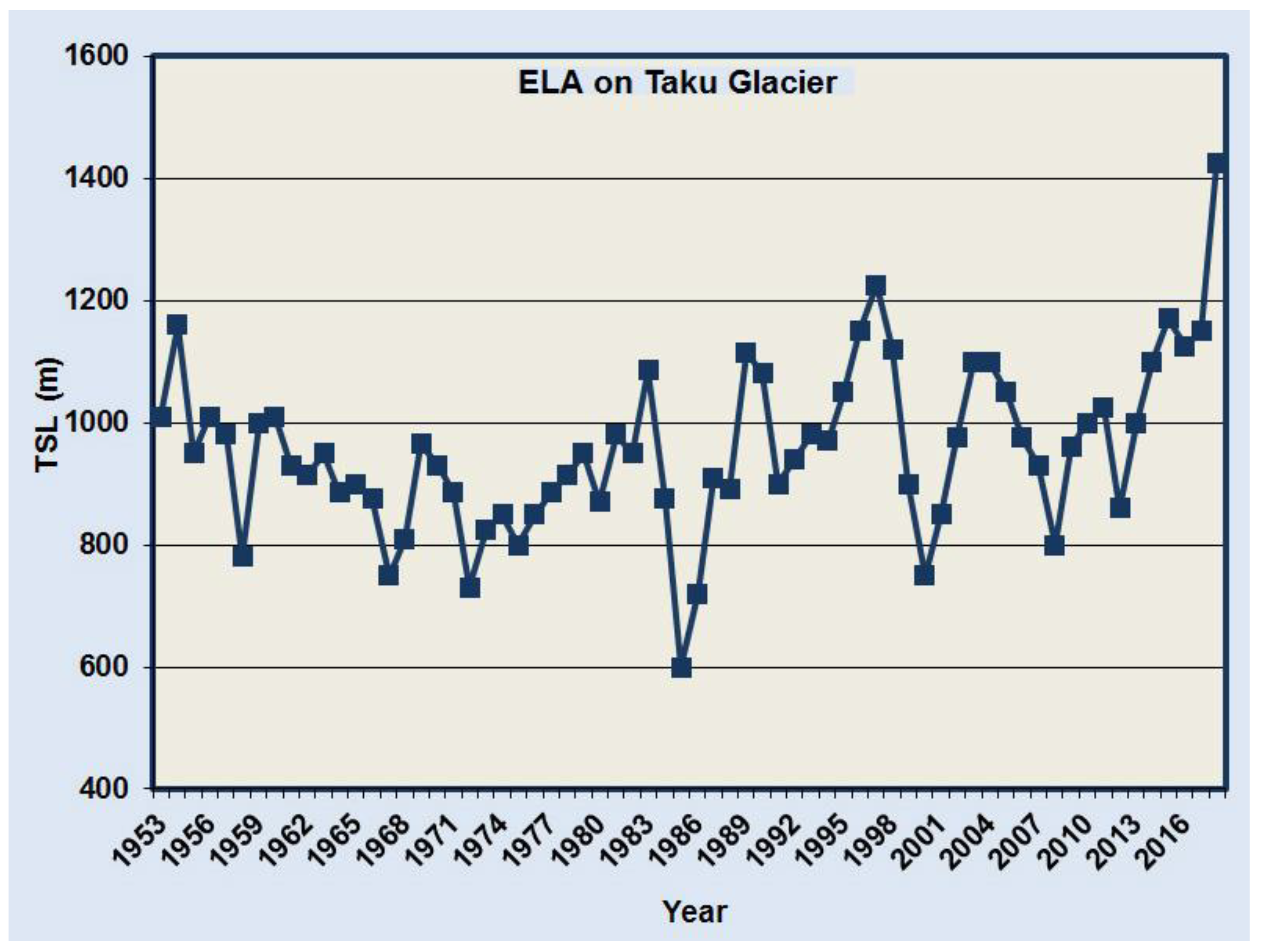
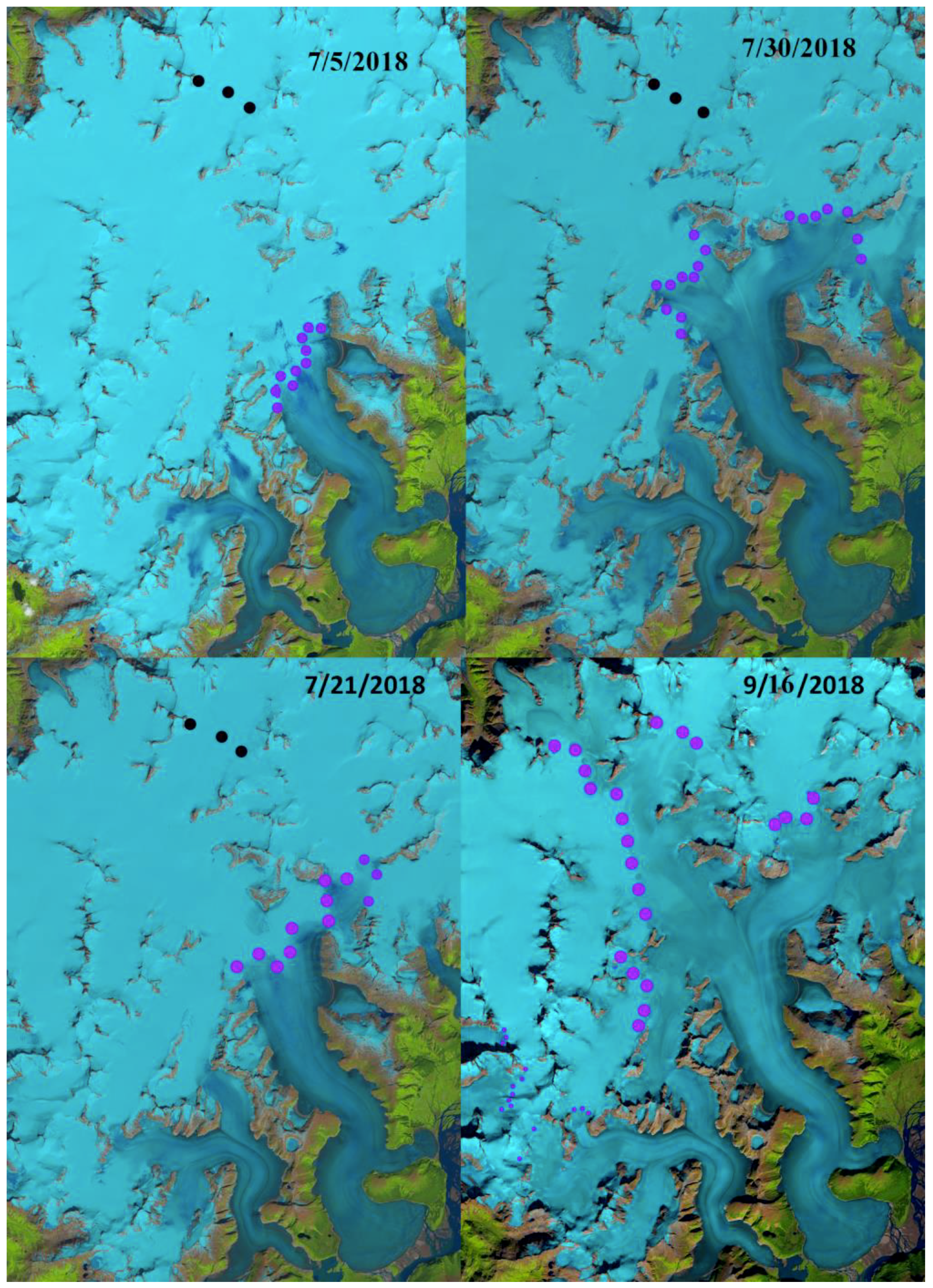
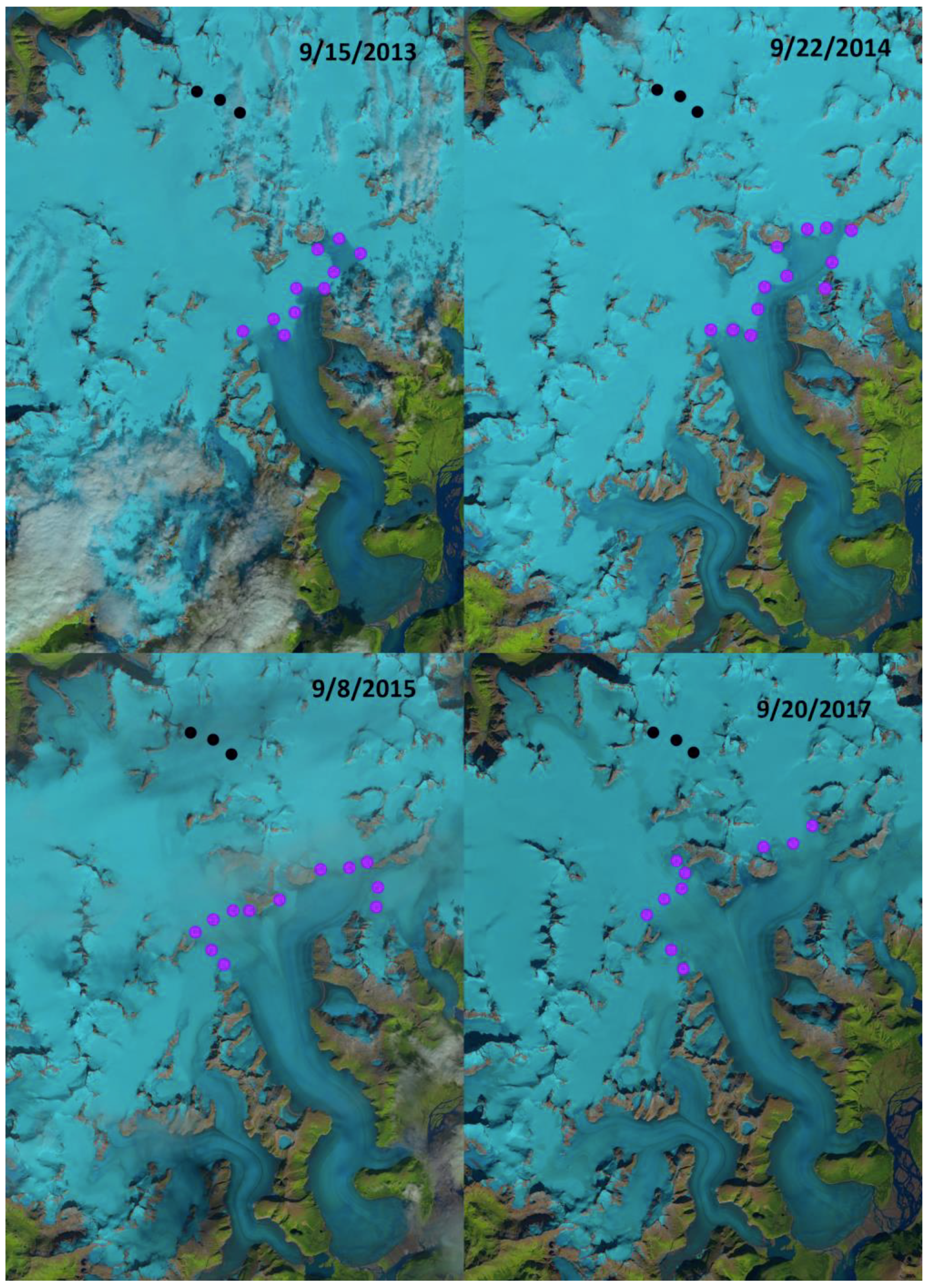
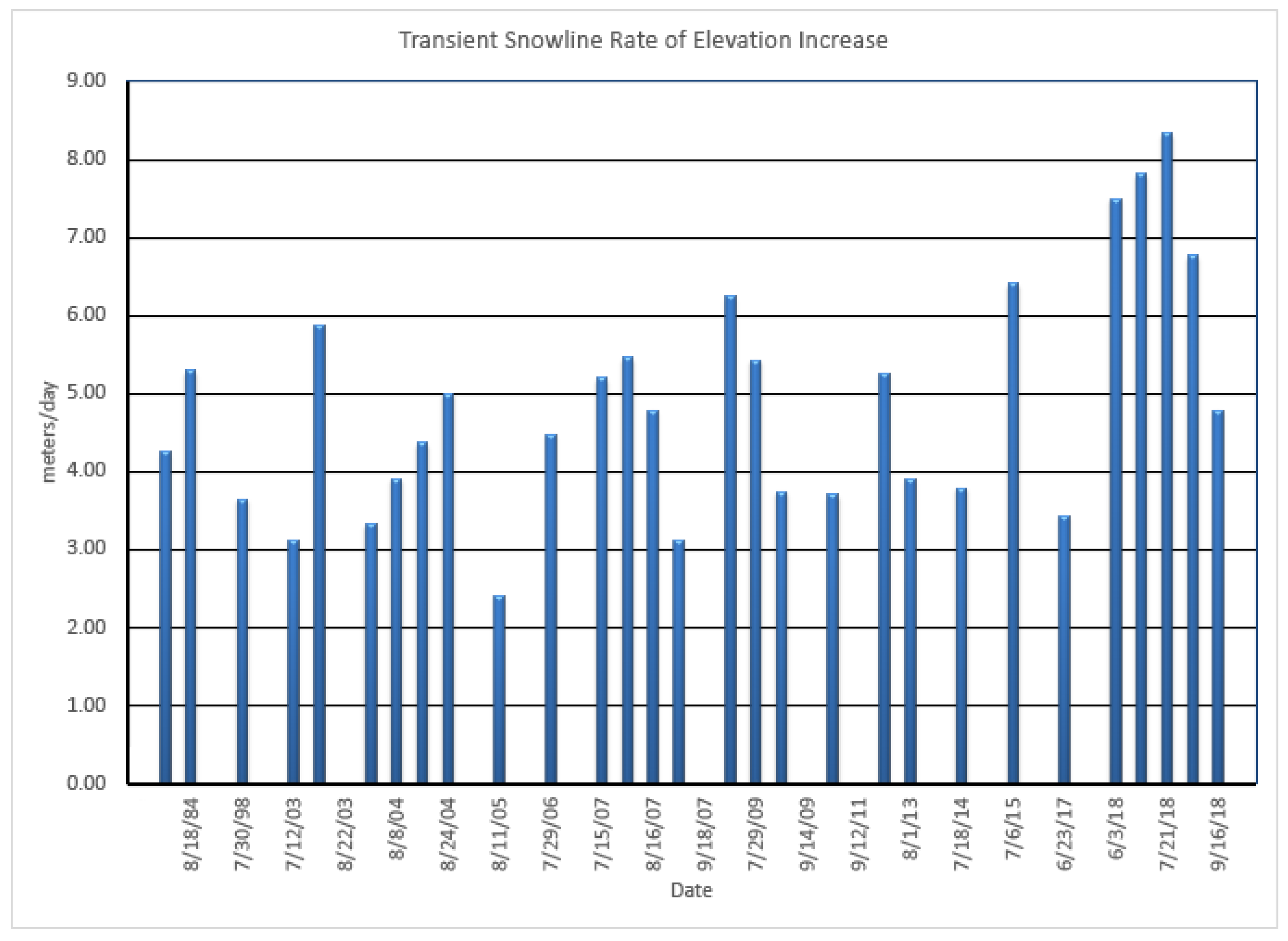
| Landsat Image | TSL (m) | Rise (m/day) | Date |
|---|---|---|---|
| LT50580191984205PAC00 | 800 | 23 July 1984 | |
| LT50580191984232PAC00 | 915 | 4.26 | 18 August 1984 |
| LT50580191984238PAC00 | 975 | 5.30 | 25 September 1984 |
| LT50580191998211PAC00 | 900 | 30 July 1998 | |
| LT50570191998259PAC00 | 1075 | 3.65 | 16 September 1998 |
| LT50580192003193PAC00 | 900 | 12 July 2003 | |
| LE0580192003217EDC02 | 975 | 3.13 | 5 August 2003 |
| LT50570192003234PAC00 | 1075 | 5.88 | 22 August 2003 |
| LT50580192004196PAC00 | 850 | 14 July 2004 | |
| LE0580192004220EDC02 | 930 | 3.33 | 8 August 2004 |
| LT50580192004228PAC00 | 975 | 3.91 | 16 August 2004 |
| LE0580192004236EDC02 | 1000 | 4.38 | 24 August 2004 |
| LT50580192004244PAC00 | 1050 | 5.00 | 31 August 2004 |
| LE0580192005223EDC00 | 925 | 11 August 2005 | |
| LE0580192005254EDC00 | 1000 | 2.42 | 11 September 2005 |
| LE0580192006229EDC00 | 760 | 29 July 2006 | |
| LE0580192006257EDC00 | 975 | 4.48 | 15 September 2006 |
| LE0570192007196EDC00 | 725 | 15 July 2007 | |
| LE0570192007221EDC00 | 850 | 5.21 | 8 August 2007 |
| LE0580192007228EDC00 | 900 | 5.47 | 16 August 2007 |
| LT50570192007245PAC00 | 965 | 4.79 | 2 September 2007 |
| LT50570192007261PAC00 | 975 | 3.13 | 18 September 2007 |
| LE0570192009194EDC00 | 700 | 13 July 2009 | |
| LE0570192009210EDC00 | 800 | 6.25 | 29 July 2009 |
| LE0580192009217SGS02 | 825 | 5.43 | 5 August 2009 |
| LT50580192009257PAC00 | 950 | 3.75 | 14 September 2009 |
| LT50570192011192PAC01 | 800 | 20 July 2011 | |
| LE0580192011255EDC00 | 1000 | 3.70 | 12 September 2011 |
| LC80570192013194LGN00 | 750 | 13 July 2013 | |
| LC80570192013213LGN00 | 850 | 5.26 | 1 August 2013 |
| LC80570192013245LGN00 | 975 | 3.91 | 2 September 2013 |
| LE0580192014199ASN00 | 875 | 18 July 2014 | |
| LC80570192014232LGN00 | 1000 | 3.79 | 20 August 2014 |
| LC80570192015187LGN00 | 850 | 6 July 2015 | |
| LC80580192015226LGN00 | 1100 | 6.41 | 14 August 2015 |
| L1C_T08VNK_A010464_20170623T | 725 | 23 June 2017 | |
| LC08_L1TP_0580192017920-T1 | 1100 | 3.44 | 20 September 2017 |
| L1C_T08VNk_A06489_20180603T | 650 | 3 June 2018 | |
| LC08_L1TP_05801920180705_T1 | 875 | 7.50 | 5 July 2018 |
| LC08_L1TP_05801920180721_T1 | 1000 | 7.81 | 21 July 2018 |
| LC08_L1TP_05701920180730_T1 | 1075 | 8.33 | 30 July 2018 |
| LC08_L1TP_05701920180916_T1 | 1400 | 6.77 | 16 September 2018 |
| LC08_L1TP_05701920181010_T1 | 1425 | 4.93 | 10 October 2018 |
| Start Date | End Date | Days | Rise | Rate of Rise | Ablation |
|---|---|---|---|---|---|
| 23 July 1984 | 18 August 1984 | 27 | 140 | 4.26 | 22 |
| 23 July 1984 | 25 August 1984 | 34 | 200 | 5.30 | 27 |
| 30 July 1998 | 16 September 1998 | 48 | 175 | 3.65 | 19 |
| 12 July 2003 | 5 August 2003 | 24 | 75 | 3.13 | 16 |
| 5 August 2003 | 22 August 2003 | 17 | 100 | 5.88 | 30 |
| 14 July 2004 | 8 August 2004 | 24 | 80 | 3.33 | 17 |
| 14 July 2004 | 16 August 2004 | 32 | 125 | 3.91 | 20 |
| 8 August 2004 | 24 August 2004 | 16 | 70 | 4.38 | 22 |
| 16 August 2004 | 31 August 2004 | 15 | 75 | 5.00 | 26 |
| 11 August 2005 | 11 September 2005 | 31 | 75 | 2.42 | 12 |
| 29 July 2006 | 15 September 2006 | 48 | 215 | 4.48 | 23 |
| 15 July 2007 | 8 August 2007 | 24 | 125 | 5.21 | 27 |
| 15 July 2007 | 16 August 2007 | 32 | 175 | 5.47 | 28 |
| 8 August 2007 | 2 September 2007 | 25 | 115 | 4.79 | 24 |
| 13 July 2009 | 5 August 2009 | 23 | 125 | 5.43 | 28 |
| 5 August 2009 | 14 September 2009 | 42 | 125 | 3.75 | 19 |
| 20 July 2011 | 12 September 2011 | 54 | 200 | 3.70 | 19 |
| 13 July 2013 | 1 August 2013 | 19 | 100 | 5.26 | 27 |
| 1 August 2013 | 2 September 2013 | 32 | 125 | 3.91 | 20 |
| 18 July 2014 | 20 August 2014 | 33 | 125 | 3.79 | 19 |
| 6 July 2015 | 14 August 2015 | 39 | 250 | 6.41 | 33 |
| 3 June 2017 | 20 September 2017 | 109 | 375 | 3.44 | 18 |
| 5 July 2018 | 21 July 2018 | 16 | 125 | 7.81 | 40 |
| 5 July 2018 | 30 July 2018 | 25 | 200 | 8.00 | 43 |
| 30 July 2018 | 16 September 2018 | 48 | 325 | 6.77 | NA |
| 30 July 2018 | 10 October 2018 | 73 | 350 | 4.93 | NA |
| Snow pit | Elevation (m) | Date of Observation | SWE (m w.e.) | Complete Snowpack Loss |
|---|---|---|---|---|
| TK5 | 988 | 11 July | 0.58 | 21 July |
| DG1 | 1018 | 14 July | 0.48 | 30 July |
| SW2 | 1096 | 14 July | 0.81 | 30 July |
| TK4 | 1112 | 10 July | 0.93 | 15 August |
| TK3 | 1203 | 13 July | 1.07 | 16 September |
| TK2 | 1269 | 18 July | 0.93 | 16 September |
| TK7 | 1339 | 18 July | 1.1 | 16 September |
| MG1 | 1405 | 22 July | 0.93 | 16 September |
© 2019 by the author. Licensee MDPI, Basel, Switzerland. This article is an open access article distributed under the terms and conditions of the Creative Commons Attribution (CC BY) license (http://creativecommons.org/licenses/by/4.0/).
Share and Cite
Pelto, M. Exceptionally High 2018 Equilibrium Line Altitude on Taku Glacier, Alaska. Remote Sens. 2019, 11, 2378. https://doi.org/10.3390/rs11202378
Pelto M. Exceptionally High 2018 Equilibrium Line Altitude on Taku Glacier, Alaska. Remote Sensing. 2019; 11(20):2378. https://doi.org/10.3390/rs11202378
Chicago/Turabian StylePelto, Mauri. 2019. "Exceptionally High 2018 Equilibrium Line Altitude on Taku Glacier, Alaska" Remote Sensing 11, no. 20: 2378. https://doi.org/10.3390/rs11202378
APA StylePelto, M. (2019). Exceptionally High 2018 Equilibrium Line Altitude on Taku Glacier, Alaska. Remote Sensing, 11(20), 2378. https://doi.org/10.3390/rs11202378






